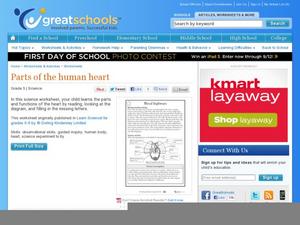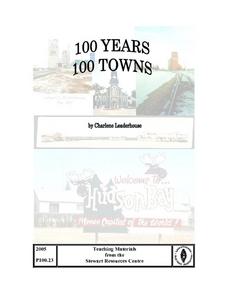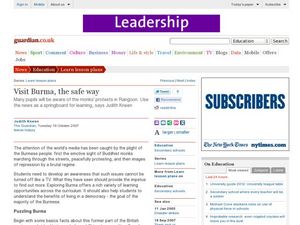Curated OER
Art Exposes
Young scholars view examples of art forms of specific artists. They choose one artist from the country they are studying and present information along with a slide show. Studenys create their own work of art in the style of their chosen...
Curated OER
The Bus Ride Teacher's Guide
Students examine and respond to the text, The Bus Ride. In this African-American literature lesson, students explore pre-reading questions that focus on fairness of laws. Students read the text based on Rosa Parks and answer 11...
Curated OER
Parts of Speech: Active Verbs
Students use White Fang to help them study active verbs. In this grammar lesson, students define active verbs and find examples in the the novel White Fang. Students then use ProQuest to research a place they'd like to visit. Students...
Curated OER
Orangeburg Massacre
Young scholars study the Orangeburg Massacre. In this social studies lesson plan, students discuss the Civil Rights Movement and the protest movements that took place. Young scholars examine the events that led up to the Orangeburg...
Curated OER
Where Do You Live?
Second graders study and compare rural, suburban, and urban communities. They play a board game, read books about communities, and complete several other activities regarding the different types of communities. Several extension and...
Curated OER
Democracy through Parliamentary Committees / Lessons 2 : Selecting and Studying a Specific Bill
Students appreciate and respect the advantages of Canada's parliamentary system. They engage in a lesson which illustrates the important role committees play in drafting bills.
Curated OER
Blood Highways
Fifth graders read an informative paragraph about how blood travels through our bodies. Then, they fill in the missing letters for words that label things in the circulatory system. An answer key is provided on page two. An interesting,...
Curated OER
Plants and Animals: Alike and Not Alike
After reading an informative paragraph that outlines some of the differences between plants and animals, fifth graders attempt to correctly categorize 12 words in a word bank. They must put them in the plant, or animal category. This...
Curated OER
Word Problems
Here is a very nice resource that presents 12 math word problems suitable for third and fourth graders. All four of the basic operations are used in these one-step problems. An answer key is provided on page two. This would make a very...
Curated OER
100 Years 100 Towns
Students study Saskatchewan's Centennial by researching the history. They determine how the town celebrates the Centennial and write a report about it based on the given rubric..
Curated OER
Visit Burma, the Safe Way
Students virtually travel to Burma. In this Burma lesson, students research Burma's history, religion, and current events as they visit selected websites and share their findings.
Curated OER
Will the Real Ben Franklin Please Stand Up?
Learners explore the life of Benjamin Franklin. In this American history instructional activity, students research primary and secondary documents regarding Franklin's life. Learners should examine the point of view each of the accounts...
Curated OER
Desert Discoveries
Students correspond with Israeli students from Jerusalem by email as part of a study on desert and semi-arid regions. They conduct background research and become proficient in the use of electronic mail.
Curated OER
Sea Turtle
Students listen to a story about a sea turtle sanctuary. They participate in a discussion about the sea turtles. They analyze some of the hazards that can hurt sea turtles and brainstorm ways to help the problem. They write and...
Curated OER
Days of the Week
Cover both capitalization and the days of the week with a great kindergarten activity! Kids read each day of the week out loud, then write the name of the day on a line. They answer three questions about certain days of the week,...
Curated OER
Poems: calligrams
Have fun with shape poems! First and second graders write calligrams that add to the meaning of their poems. Great for your poetry unit or if you want to combine poetry and art lessons.
Curated OER
Lowercase and Uppercase #1
Practice with uppercase and lowercase letters using this matching learning exercise. There are several letters here and scholars match the ones that make the same sound. The trick is that the matching pairs are between capitals and...
Curated OER
Match the Words
Even if your kids aren't reading yet, they can become familiar with words by identifying two that are the same. Youngsters focus on the word same as they examine eight words and match them to their identical spellings....
Curated OER
Syllables
How many syllables? This practice activity starts with a brief introduction on segmenting words, encouraging kids to say words aloud. They categorize 12 words into lists based on number of syllables: one, two, or...
Curated OER
Contractions
Shorten words with contractions. Second graders use apostrophes to shorten words, including harder ones like might not. Next, they write out the longer versions of various contractions. Have them write a story with these contractions for...
Penguin Books
An Educator’s Guide to Chraisma by Jeanne Ryan
Often, science fiction makes a lot of connections to real life. An educator's guide for the novel Charisma by Jeanne Ryan, has readers discuss many of the real-life issues that come in the text. A brief summary helps garner interest...
Curated OER
Bend It! Stretch It! Squash It!
Some items keep their shape no matter what happens! Have your kindergarten class choose which items would stay the same if they were bent, stretched, or squashed. The last activity prompts kids to see what happens when they stretch a...
Curated OER
Feel the Vibrations
How does sound travel in a string walkie-talkie? Third graders read about the way vibrations act between two cups and a string. Next, they put the steps in order, and experiment with their own walkie-talkies.
Curated OER
Food chains at sea
Fifth graders interpret a table of data about food chains in the ocean. They create a food chain to represent the information on the table. Periwinkles eat seaweed, and crabs eat periwinkles - so who eats crabs? Extend the activity with...























